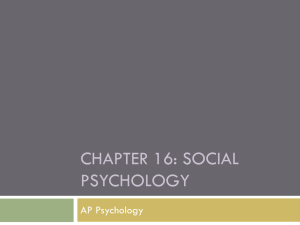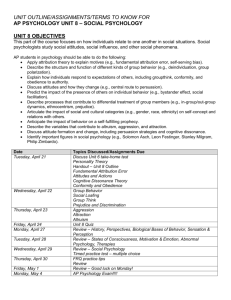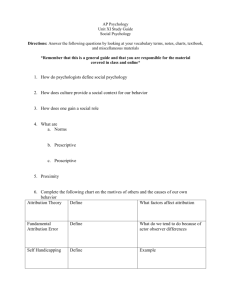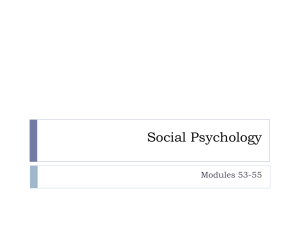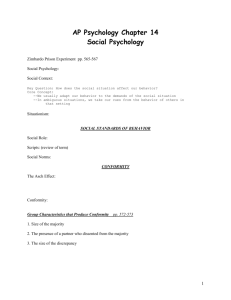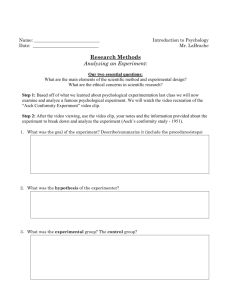Social Psych Notes
advertisement
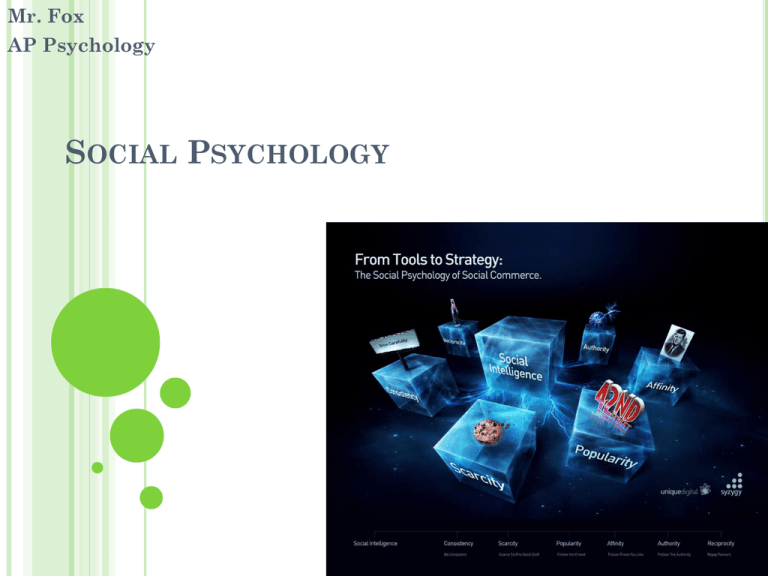
Mr. Fox AP Psychology SOCIAL PSYCHOLOGY SOCIAL PSYCHOLOGY Social psychology: Psychology that studies the effects of social variables and cognitions on individual behavior and social interaction. Social psychology looks at how people’s thoughts, feelings, perceptions, motives and behavior are influenced by other people. It tries to understand behavior and mental processes within its social context. SOCIAL CONTEXT Social context includes the real, imagined, or symbolic presence of other people; the activities and interactions that take place among people; the settings in which behavior occurs; and the expectations and social norms governing behavior in a given setting (Sherif, 1981). MAJOR THEMES OF SOCIAL PSYCHOLOGY There are three major themes of social psychology 1. The power of social situations 2. Subjective social reality 3. The promotion of human condition SITUATIONISM VS. DISPOSITIONISM Situationism: A view that says environmental conditions influence people’s behavior as much or more than their personal disposition does. Dispositionism: A view that says internal factors (genes, traits, character qualities) influence our behavior more than the situation we are in. Regardless of your view, people’s behavior depends heavily on two factors: the social roles they play, and the social norms of the group. SOCIAL STANDARDS OF BEHAVIOR Social Roles: One of several socially defined patterns of behavior that are expected of persons in a given setting or group. The roles people assume may be the result of a person’s interests, abilities and goals, or they may be imposed on a person by cultural, economic or biological conditions. SOCIAL STANDARDS OF BEHAVIOR Social Norms: A group’s expectations regarding what is appropriate and acceptable for it’s members’ attitudes and behaviors in given situations. SOCIAL NORM ACTIVITY Break a Social Norm – Get Visual Evidence of norm breaking. MAKING COGNITIVE ATTRIBUTIONS Explaining to ourselves why people act the way they do. CLASS ACTIVITY Now you guys have a unique opportunity. We are going to take a break from notes as I want your feedback. Find a way to mask your handwriting (ALL CAPS MAYBE) Get out a scrap piece of paper, DO NOT write your name on it. Please describe me. What you exactly think of me. Be completely honest. There can be no punishment or retribution of any kind. Now do the same for your least favorite teacher, if they are different :-/ COGNITIVE DISSONANCE Cognitive Dissonance: A highly motivating state in which people have conflicting cognitions, two or more contradictory beliefs, ideas, or values at the same time, or is confronted by new information that conflicts with existing beliefs, ideas, or values Term discovered by Leon Festinger Marines in boot camp “Pain is weakness leaving the body” COGNITIVE DISSONANCE THEORY Cognitive dissonance theory says that when people’s cognitions and actions are in conflict (a state of dissonance) they often reduce the conflict by changing their thinking to fit their behavior. Festinger believed humans strive for internal consistency Examples of cognitive dissonance theory in action? EXAMPLE OF COGNITIVE DISSONANCE Smokers tend to experience cognitive dissonance because it is widely accepted that cigarettes cause lung cancer, yet virtually everyone wants to live a long and healthy life. In terms of the theory, the desire to live a long life is dissonant with the activity of doing something that will most likely shorten one's life. The tension produced by these contradictory ideas can be reduced by quitting smoking, denying the evidence of lung cancer, or justifying one's smoking. For example, a smoker could rationalize his or her behavior by concluding that everyone dies and so cigarettes do not actually change anything. Or a person could believe that smoking keeps one from gaining weight, which would also be unhealthy. FUNDAMENTAL ATTRIBUTION ERROR We tend to attribute people’s behavior and misfortunes to their personal traits rather than situational forces. The Fundamental Attribution Error (FAE) is the tendency to overemphasize personal traits while minimizing situational influences. Assigning the causality to personal characteristics when causality actually lies with the situation. AN EXAMPLE… Think about the last time you were driving and were cut off by another car. Did you think: a) “what an idiot – that guy is a terrible driver;” or b) “That guy must have a good reason to be in such a hurry.” SELF-SERVING BIAS While FAE is a pitfall of judging other people, a selfserving bias is a error in the way we look at and interpret ourselves and the situations we find ourselves in. Self-Serving Bias is the tendency for us to judge ourselves by a double standard: a) When things go well, the success is a result of our own internal factors like motivation, talent or skill. b) When things go poorly it was the result of some uncontrollable external factor. PREJUDICE AND DISCRIMINATION PREJUDICE AND DISCRIMINATION Our judgments about people can be both positive and negative, but prejudice is always a negative judgment. Often people get these two terms confused, though they are very different. Prejudice is having negative thoughts, emotions, attitudes or feelings towards an individual solely based on his membership in a particular group. Where prejudice is an attitude, discrimination is a negative action taken against a person because of his membership in a group. 6 CAUSES OF DISCRIMINATION 6 causes of discrimination social Psychologists have identified: Dissimilarity and Social Distance: The perceived difference between two people-usually culturally based 2. Economic Competition: When one group wins economic benefits at the expense of another group 1. o 3. Ex: old growth logging: jobs vs. environment Scapegoating: Blaming an innocent person for one’s own troubles o Jewish people during Nazi Germany Conformity to Social Norms: An “unthinking tendency” to keep things the way they are, even if they may be wrong 5. Media Stereotypes: Images, words or ideas used to project groups in a certain, over- generalized way. 6. Social Identity Theory- Groups are a source of pride and selfesteem, so we enhance the status of this group and divide the world into us and them. 4. ROBBERS CAVE Muzafer Sherif – Realistic Conflict Theory Cause of prejudice, stereotypes, conflict The Robber’s Cave Experiment (1954, 1961) Competition for limited resources 22 - 12 year old boy scouts at a start park in OK. Unknown, all of the same demographic. Did not know of the other group, just put in an environment to develop an in-group status. (Eagles and Rattlers) Then Sherif brought the two groups into competition with each other (i.e. tug of war) with team and individual prizes. Within a week physical fights broke out SOCIAL INFLUENCE Conformity, Obedience, Social Pressure SOCIAL PRESSURE Social pressure can create powerful psychological effects such as prejudice, discrimination, blind obedience, and violence. Social roles, rules, how we are dressed, competition, or the mere presence of others can profoundly influence how we behave and think. We usually adapt our behavior to the demands of the social situation, and in ambiguous situations, we take our cues from the behavior of others in that setting. CONFORMITY When people interact in groups, there are specific psychological effects that happen. Conformity: The tendency for people to adapt their behaviors, attitudes, and opinions to fit the actions of other members of a group. Allows for cohesion in groups THE ASCH EFFECT Asch’sStudy The Asch Effect: A form of conformity in which a group majority influences individual judgments. Asch’s test had 4 trials. There were groups of 7 people, 6 of whom were aware of the test. They would be shown cards like the one above and asked which of the lines matched exhibit 1. In the first three trials, all 6 of the “knowing” participants answered correctly. The 7th participant followed correctly. On the 4th trial, the first 6 participants intentionally answered incorrectly, in an attempt to see what the 7th participant would do. ASCH’S RESULTS 75% of those subjected to group pressure conformed to the false judgment of the group one or more times, while only 25% remained completely independent. In related studies, up to 80% conformed with the majority’s false estimate at least once, while 33% yielded to the majority on half of the trials or more. CHARACTERISTICS THAT PROMOTE CONFORMITY Asch identified 3 factors that influence whether a person will yield to group pressure: 1. The size of the majority 2. The presence of a partner who dissented from the majority 3. The size of the discrepancy between the correct answer and the majority’s opinion. CONFORMITY Conformity increases when… You feel incompetent or insecure. You are in a group of 3 or more. You are impressed by the status of the group. You have made no prior commitment to a response. You are being observed by the others in the group. Your culture strongly encourages respect for social standards. OBEDIENCE Obedience – behavior that complies with explicit demands of the individual in authority Stanley Milgram – How far would people be willing to shock another person when ordered to do so During the study, the majority of the teachers obeyed the experimenter: Almost two-thirds delivered the full 450 volts. SOCIAL PRESSURE LEADS TO: Deindividuation: Loss of selfawareness and self-restraint occurring in group situations that foster action and anonymity. Social Contagion: Emotion can spread rapidly through large crowds, as the massive social group leads us into extreme states. IQ drops as crowd size and emotion increases CONTAGION Researchers at Harvard University have come to the conclusion that fat friends and others in our social networks lead to obesity. Liken it to a virus Predict obesity rates to rise to 42% of the adult population "within the next 40 years or so." Each social interaction a person has with someone who is obese raises their chance of becoming obese by 1/2 of one percent, This means that obesity would continue to increase very quickly and NOT slow down if the "social contagion" theory were true. Other experts earlier this year made the claim that US obesity rates would top out at the current 34%. Critics of those claims point out that state reporting of obesity is undercalculated because it relies too heavily on non-medical data. GROUPTHINK AND RISKY SHIFT Risky Shift: Tendency for a group decision to be riskier than the average decision made by the individual group members Groupthink: The mode of thinking that occurs when the desire for harmony in a decision-making group overrides a realistic view of the alternatives. Factors that promote groupthink: Isolation of the group High group cohesiveness Directive leadership Lack of norms requiring methodical procedures Homogeneity of members’ social background High stress from external threats Where do we see Groupthink in our lives? GROUP POLARIZATION Group Polarization: When members of a group have similar, though not identical, views about a topic and discuss them, their opinions become more extreme and pronounced. Polarizing Figures HOW GROUPS IMPACT PERFORMANCE Social Facilitation: Tendency for improved performance of tasks in the presence of others. This is generally because of a heightened state of awareness. The exception is new skills Social Loafing: Tendency for people in a group to exert less effort when pooling their efforts towards a common goal. THE GOOD SIDE OF SOCIAL PSYCH: ALTRUISM, LOVE, AND HOW AND WHY WE CHOOSE GROUPS TO BE A PART OF WHAT MAKES UP A GROUP Generally, groups are characterized by three features: roles, norms and cohesiveness. Roles are an expected set of behaviors for the group members, norms are the rules of conduct, and cohesiveness is the force that pulls group members together and forms bonds that last. All of these are subject to social reality. SOCIAL REALITY Social reality: An individual’s subjective interpretation of other people and of relationships with them. Determines who we find: attractive or threatening; who we are drawn to or avoid… The judgments we make about others depend on their behavior and our interpretations of their action. SELF FULFILLING PROPHECY Expectations cause individuals to act in ways that serve to make expectations come true Rosenthal-Jacobson Experiment – Told teachers that groups were either late bloomers or had high potential. Teachers conformed to expectations. Works similar in attraction, as we give attractive people more benefit and time. ATTRACTION Mere Exposure Effect – The more we encounter something (or someone) the higher the probability we will like it, even if you don’t realize we have seen it before. ATTRACTION Other Factors in Attraction Consensual Validation – Intelligence, taste n clothes, attitudes, behavior patterns, personality, friends, values, lifestyles, physical attractiveness. We like those who like us First Impression Attributions – Primacy effect in about 100 millisecond exposure time. ATTRACTION – ATTRIBUTION THEORY People are motivated to discover the underlying causes of behavior, both their own and others. Internal and external causes (traits or social pressure) Stable or unstable causes (permanent or temporary) Controllable or Uncontrollable (are they in control of situation) INTERPERSONAL ATTRACTION Reward theory of attraction: The theory that says we like those who give us maximum rewards or benefit at minimum costs. According to this theory, attraction is a form of social learning. Psychologists have identified four especially strong sources of reward that predict interpersonal attraction. FOUR SOURCES OF ATTRACTION 1. Proximity: The idea is that people will work harder to make friends with those to whom they are closest (physically). 2. Similarity: People usually find it more rewarding to have a relationship with someone who shares the same attitudes, interests, values and experiences as they do. FOUR SOURCES OF ATTRACTION 3. Self-Disclosure: It takes time to develop the trust necessary to share intimate details about oneself. Generally we want to spend time around those who know us best. 4. Physical Attractiveness: Yes it is vain, but it is reality. People are generally attracted to those who are more physically attractive. Average=attractive Beautiful=unapproachable EXCEPTIONS TO THE RULE Although the reward theory of attraction seems to make sense, it fails to explain a few situations: A women in an abusive relationship Joining a frat/hazing Why might someone engage in these relationships? OTHER THEORIES OF ATTRACTION Reward theory of attraction is not the only theory about why we are attracted to who we are. Matching Hypothesis: A prediction that most people will find friends and mates that are perceived to be about their same level of attractiveness. OTHER THEORIES OF ATTRACTION Expectancy-Value Theory: The theory that people decide to pursue a relationship by weighing the potential value of the relationship against their chances of succeeding in that relationship. We try to have relationships with the most attractive people we think will probably like us in return, while minimizing the risk of failure Jay-Z would not give up his relationship with Beyonce for one with Lady Gaga. WHY DO SOME PEOPLE ACT SELFLESS? Altruism – helping another with no desire for personal gain Opposite of egoism, the act of giving for personal gain self-esteem, or displaying power. Acting on a principal of reciprocity is an example of egoism “The Golden Rule” WHY DO PEOPLE ACT ALTRUISTICALLY? Both mood (being happy) and empathy play major factors in resulting altruistic behavior. Can this behavior be adaptive? Family situations for sure, but is it also a part of true human nature? A split theory among evolutionary psychologists. ALTRUISM – HELPING OTHERS Seems to be two types – bio and psychological. Psychological altruism means acting out of concern for the well-being of others, without regard to your own self-interest. We feel fulfilled by helping others, both happiness and in control Biological altruism refers to behavior that helps the survival of a species without benefiting the particular individual who’s being altruistic. It has always been though that we are by nature selfish (think Darwin) but recent studies tend to show different.
